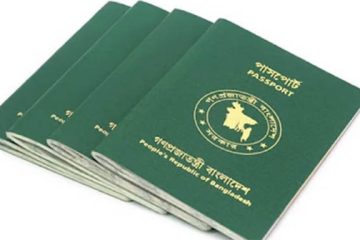Incessant rain since the early hours of Thursday threw life out of gear in different parts of the capital and elsewhere in the country. The downpour in two hours totalled 64 mm. Two persons were electrocuted when they came in contact with a snapped electric wire while crossing a water-logged road at about 10:30 am in the North-South area of Bangsal thana. They were identified as Shohag (30), a day labourer, and Sagar (38), a pedestrian.
The torrential downpour inundated various parts of the metropolis, including Kalyanpur, Mohammadpur, Asad Gate, Karwan Bazar, Motijheel,Kamalapur, Gulshan, Banani, Kazipara, Shewrapara of Mirpur, Moghbazar, Malibagh, Nayapaltan, Kakrail and Shantinagar.
Some cars broke down on the flooded streets as they were unable to negotiate the sudden waterlogging as clogged drains were unable to clear the water. It created problems for the people, especially women and children. Some of them had to wade through knee-deep water in the low lying areas of the city.
Several areas of Gazipur Sadar, including the Dhaka-Mymensingh highway, were under knee-deep water. Traffic came to a standstill in Bhogra, Basan Road, Maleker Bari and adjacent areas due to waterlogging.
Met office sources said 64 mm rain was recorded between 7 am and 9 am in Dhaka city alone. It was the highest in two hours in the city this year.
Lack of proper and adequate drainage system and poor functioning of sluice gates are among the main causes of waterlogging, causing immense sufferings to city dwellers. The wet weather also caused troubles for legions of day labourers, garment workers and the homeless. Some of them were seen in the old High Court building area, trying to shield themselves from the piercing rain by huddling together under plastic sheets.
Many CNG-run auto-rickshaws refused to take passengers to different areas, including Mohammadpur, Mowchak, Malibagh, and Motijheel. They said their vehicles would not be able to cope with the waterlogging in those areas..
A number of people had to get down from public transport before their destination. They were compelled to wade through knee-deep water and waist-deep water in some areas.
Underground water reservoirs in many buildings in different parts of the capital, including Mohammadpur, Manipuripara, Mirpur and Shewrapara also went under water.
Amir Hossain, a building owner at Shia Masjid of the Mohammadpur area, said: “Rainwater, mixed with pollutants, entered the underground water reservoir of my building. Now I have to clean the tank. The existing drainage system does not have the capacity to clear water. Today’s rain has caused serious waterlogging in my area. The authorities should take steps to keep the drains clean.” The existing drainage system can flush out only 20 mm of rainwater every hour. Normally it takes six hours to pass the water through the existing drainage system. But many of the drains are clogged due to dumping of sewerage wastes like polythene, plastics, cans and other materials, according to Dhaka Water Supply and Sewerage Authority (WASA) sources.
Taqsen A Khan, managing director of WASA, told reporters that it had taken three hours to pump out 70 mm of rain water from the city. He, however, said that certain areas are still waterlogged. “We’ve only used the Sayeedabad pumping station to flush out the rainwater,” he said. He told reporters that two more pumping stations at Kamalapur and Rampura would be made operational soon. “Then, it would be possible to clear excessive water within one hour. We’ll also have two retention ponds to reserve the extra water,” he added.
Md Shah Alam, director of the Bangladesh Meteorological Department, told The Independent that such heavy rain and temporary gusty or squally winds may again occur within this month. “Monsoon would set in from the first week of June. Then we’ll be able to forecast the weather pattern. It’s very difficult to tell anything beforehand as the variability of weather has become more complex due to climate changes. We’re trying to adapt to the changes,” he added.
-With The Independent input




















